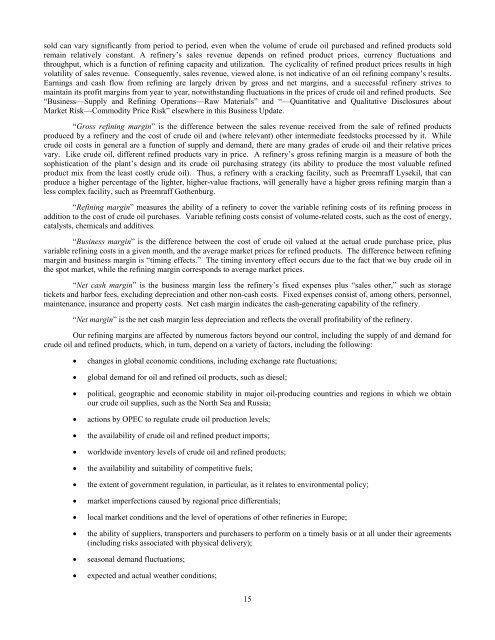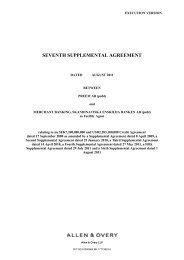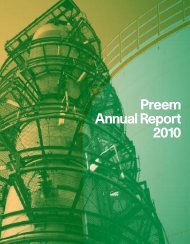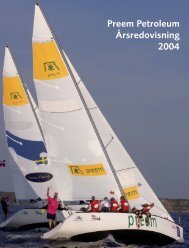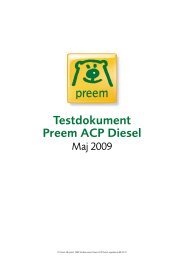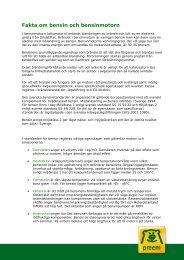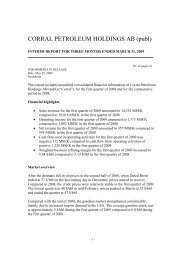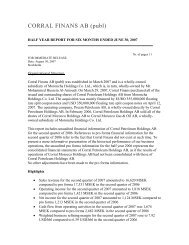MANAGEMENT’S DISCUSSION AND ANALYSIS OF FINANCIAL CONDITIONAND RESULTS OF OPERATIONSThe following is a discussion of our results of operations and financial condition for the years ended December 31,2008, 2009 and 2010 and for the six months ended June 30, 2010 and 2011. The discussions regarding our results ofoperations are based on the audited consolidated financial statements as of and for the years ended December 31, 2009 and2010 and our unaudited consolidated interim financial statements as of and for the six months ended June 30, 2011.You should read this discussion in conjunction with our audited annual consolidated financial statements and therelated notes, which audited consolidated financial statements as of and for the years ended December 31, 2009 and 2010are included elsewhere in this <strong>Business</strong> <strong>Update</strong>. We have prepared our consolidated financial statements in accordance withIFRS as adopted by the EU. The following analysis contains forward-looking statements about our future revenue, operatingresults and expectations that involve risks and uncertainties. Our actual results could differ materially from thoseanticipated in the forward-looking statements as a result of numerous factors, including the risks discussed in “Risk Factors”and elsewhere in this <strong>Business</strong> <strong>Update</strong>.Overview of the <strong>Business</strong>We are the largest oil refining company in the Nordic region in terms of capacity. We conduct our business throughour wholly owned operating company, <strong>Preem</strong>, which operates its business through two segments, a supply and refiningsegment and a marketing segment. We refine crude oil in Sweden and then market and sell refined products primarily inSweden and other northwestern European markets, including Scandinavia, France, Germany and the United Kingdom, aswell as the United States and, to a lesser extent, other markets. Our refineries represented approximately 80% of the refiningcapacity in Sweden and approximately 30% of the refining capacity in the Nordic region in 2010. We sell more refinedproducts in Sweden than any of our competitors. In Sweden, we had the leading market share in 2010 in terms of salesvolume of diesel, heating oil and fuel oil with approximately 35% of diesel sales, 49% of heating oil sales and 52% of fuel oilsales, according to the Swedish Statistical Central Bureau. In addition, our marketing segment’s share of the Swedish retailgasoline and diesel markets in terms of sales volume were approximately 12% and 25%, respectively, in 2010, based on datafrom the Swedish Statistical Central Bureau.Our supply and refining segment purchases and refines crude oil and then sells refined products wholesale to ourmarketing segment and to third parties. We also own a strategically located network of storage depots in Sweden. In 2010,our supply and refining segment sold approximately 80% (by value) of its products to third parties and 20% (by value) to ourmarketing segment as compared to 81% (by value) and 19% (by value), respectively, in 2009. For the years ended December31, 2010, 2009 and 2008, our supply and refining segment had sales revenue of SEK 76,050 million (€8,314 million), SEK61,870 million (€6,764 million) and SEK 85,336 million (€9,329 million) and operating income of SEK 2,693 million (€294million), operating income of SEK 4,847 million (€530 million) and operating loss of SEK 672 million (€73 million),respectively. For the six months ended June 30, 2010 and 2011, our supply and refining segment had sales revenue of SEK39,916 million (€4,364 million) and SEK 45,048 million (€4,925 million) and operating income of SEK 1,229 million (€134million) and SEK 1,454 million (€159 million), respectively.Our marketing segment consists of two divisions: a business-to-business division and a station and consumerdivision. The marketing segment resells refined products, wholesale, primarily in Sweden. We also sell our gasoline anddiesel through approximately 390 <strong>Preem</strong>-branded manned and unmanned service stations, which are company-owned anddealer-operated, along with approximately 180 company-owned Såifa-branded diesel truck stops. For the years endedDecember 31, 2010, 2009 and 2008, our marketing segment had sales revenue of SEK 16,822 million (€1,839 million), SEK13,702 million (€1,498 million) and SEK 16,140 million (€1,765 million) and operating income of SEK 349 million (€38million), operating income of SEK 213 million (€23 million) and operating loss of SEK 6 million (€1 million), respectively.For the six months ended June 30, 2010 and 2011, our marketing segment had sales revenue of SEK 8,222 million (€899million) and SEK 10,072 million (€1,101 million) and operating income of SEK 184 million (€20 million) and SEK 203million (€22 million), respectively.Key Factors Affecting Results of Operationsfactors.Our results of operations during the period under consideration have been primarily affected by the followingRefining MarginsOil refineries measure the financial performance of their operations by their margins. Prices for crude oil andrefined products are subject to frequent and significant fluctuations. As a result, a refinery’s sales revenue and cost of goods14
sold can vary significantly from period to period, even when the volume of crude oil purchased and refined products soldremain relatively constant. A refinery’s sales revenue depends on refined product prices, currency fluctuations andthroughput, which is a function of refining capacity and utilization. The cyclicality of refined product prices results in highvolatility of sales revenue. Consequently, sales revenue, viewed alone, is not indicative of an oil refining company’s results.Earnings and cash flow from refining are largely driven by gross and net margins, and a successful refinery strives tomaintain its profit margins from year to year, notwithstanding fluctuations in the prices of crude oil and refined products. See“<strong>Business</strong>—Supply and Refining Operations—Raw Materials” and “—Quantitative and Qualitative Disclosures aboutMarket Risk—Commodity Price Risk” elsewhere in this <strong>Business</strong> <strong>Update</strong>.“Gross refining margin” is the difference between the sales revenue received from the sale of refined productsproduced by a refinery and the cost of crude oil and (where relevant) other intermediate feedstocks processed by it. Whilecrude oil costs in general are a function of supply and demand, there are many grades of crude oil and their relative pricesvary. Like crude oil, different refined products vary in price. A refinery’s gross refining margin is a measure of both thesophistication of the plant’s design and its crude oil purchasing strategy (its ability to produce the most valuable refinedproduct mix from the least costly crude oil). Thus, a refinery with a cracking facility, such as <strong>Preem</strong>raff Lysekil, that canproduce a higher percentage of the lighter, higher-value fractions, will generally have a higher gross refining margin than aless complex facility, such as <strong>Preem</strong>raff Gothenburg.“Refining margin” measures the ability of a refinery to cover the variable refining costs of its refining process inaddition to the cost of crude oil purchases. Variable refining costs consist of volume-related costs, such as the cost of energy,catalysts, chemicals and additives.“<strong>Business</strong> margin” is the difference between the cost of crude oil valued at the actual crude purchase price, plusvariable refining costs in a given month, and the average market prices for refined products. The difference between refiningmargin and business margin is “timing effects.” The timing inventory effect occurs due to the fact that we buy crude oil inthe spot market, while the refining margin corresponds to average market prices.“Net cash margin” is the business margin less the refinery’s fixed expenses plus “sales other,” such as storagetickets and harbor fees, excluding depreciation and other non-cash costs. Fixed expenses consist of, among others, personnel,maintenance, insurance and property costs. Net cash margin indicates the cash-generating capability of the refinery.“Net margin” is the net cash margin less depreciation and reflects the overall profitability of the refinery.Our refining margins are affected by numerous factors beyond our control, including the supply of and demand forcrude oil and refined products, which, in turn, depend on a variety of factors, including the following:changes in global economic conditions, including exchange rate fluctuations;global demand for oil and refined oil products, such as diesel;political, geographic and economic stability in major oil-producing countries and regions in which we obtainour crude oil supplies, such as the North Sea and Russia;actions by OPEC to regulate crude oil production levels;the availability of crude oil and refined product imports;worldwide inventory levels of crude oil and refined products;the availability and suitability of competitive fuels;the extent of government regulation, in particular, as it relates to environmental policy;market imperfections caused by regional price differentials;local market conditions and the level of operations of other refineries in Europe;the ability of suppliers, transporters and purchasers to perform on a timely basis or at all under their agreements(including risks associated with physical delivery);seasonal demand fluctuations;expected and actual weather conditions;15


